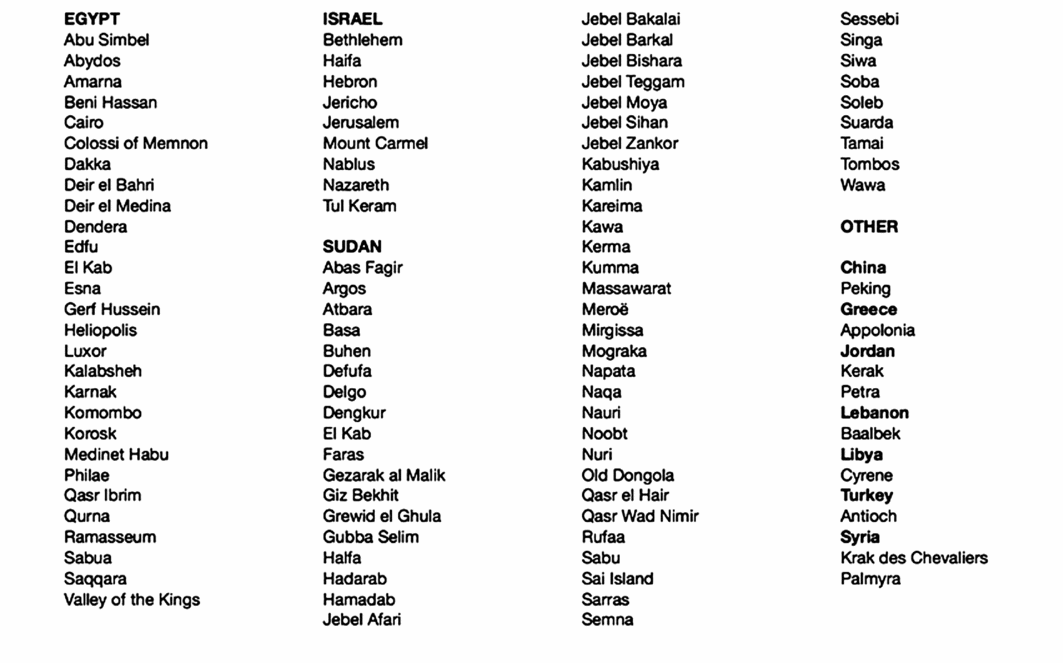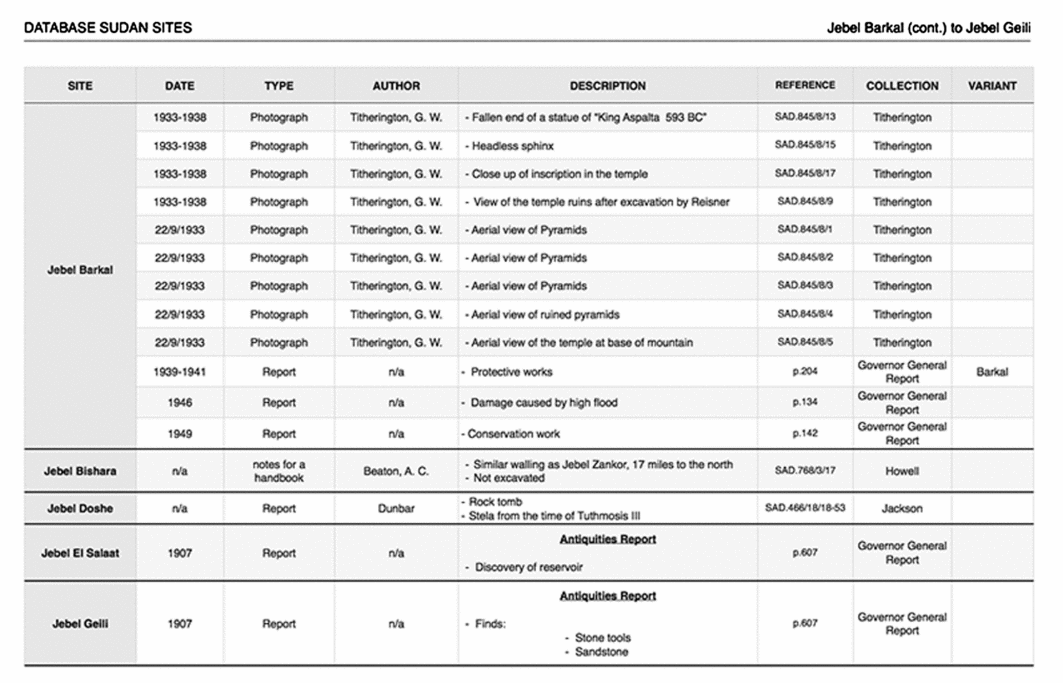Durham University's Sudan Archive was founded in 1957 by former members of the Sudan Government under the Anglo-Egyptian Condominium, and by staff from Durham University, including the first director of the Oriental Museum, T.W. Thacker (Cory & Forbes Reference Cory and Forbes1983). Since the initial call for donations, the Sudan Archive has now collected 800 boxes of documents and photographs, mainly from former Sudan Government officials. This material now forms an integral part of Durham University Library's special collections (Sudan Archive Catalogue). The archive holds a wide variety of documents, from personal communications and photographs, to official reports mainly pertaining to political and social issues from early twentieth-century Sudan and neighbouring countries. It also includes a wealth of material relevant to the archaeology of both the Sudan and neighbouring countries (e.g. Egypt, Israel, Syria) (Figure 1), yet only a limited amount of the potentially relevant material has been used by archaeologists. The Sudan Archive remains a largely untapped resource for archaeological research. This situation is probably to be explained partly by the description of the archive as a historical and political collection; moreover, a search of the existing catalogue for the term ‘archaeology’ returns only four results, whereas about 700 documents are directly relevant to the subject. An additional problem is that the spellings of both archaeological sites and locations are inconsistent; for example, Meroë also appears as Meroe, Merowe and Bakarwiyyeh. To remedy these issues and to make the material more accessible, a recent project has identified over 1000 individual references to archaeological sites or themes and catalogued them in a database (Figure 2).

Figure 1. List of archaeological sites and monuments referenced in the Sudan Archive.

Figure 2. Screenshot of part of the database.
The material in the Sudan Archive dates to the Anglo-Egyptian Condominium in the Sudan between 1898 and 1956. While not a true British Colony, this was essentially a period of near complete British control in the Sudan. The country was overseen by a British Governor General who reported to the High Commissioner in Egypt (Collins Reference Collins2008: 33). The archaeological material in the archive covers most of the period of the Condominium, albeit with variations in quantity, especially during the two world wars (Figure 3). The recording of archaeological activity in the country at the time was inconsistent, and not every excavation was published. Of the official excavations referred to in the archive, only about one third are the subject of dedicated excavation reports available elsewhere. This highlights the huge potential of the Sudan Archive, allowing researchers to identify archaeological work from the twentieth century that may not be covered in other published, or even unpublished, sources.

Figure 3. Number of references to archaeological sites in the Sudan Archive between 1895 and 1945.
The archaeologically relevant material in the Sudan Archive is contained within a variety of document types. These include photographs, which are the most common category, although Egypt is better represented than the Sudan. Many of these photographs show archaeological sites and monuments before their clearance and reconstruction by archaeologists, or, in some cases, their removal in advance of dam construction. The photographs in the archive deserve a more detailed study in their own right. During the project, it was noted that several of the temples have been misidentified; there are also photographs of the Syrian sites of Palmyra and Krak des Chevaliers from 1951 that may be of increased value as a result of the current political climate in that country.
The written material is predominately correspondence. This includes both official letters between Sudan Government officials and archaeologists, as well as personal correspondence to family members or friends back in Europe. These letters often provide quite detailed accounts of excavations carried out in the Sudan; for example, a letter by Reisner describes his ongoing excavation of a pyramid at Jebel Barkal in 1916 (Reisner Reference Reisner1916). Others criticise or praise the methods of individual archaeologists at the time. Collectively, these letters provide a unique insight into both the discoveries by individual excavations and the way excavations, and indeed archaeologists, were perceived by their contemporaries, be they colleagues or government officials. Some of the exchanges are particularly amusing and involve members of the Sudan Government attempting to placate disputes between excavators. As a primarily non-archaeological archive, the Sudan Archive helps to provide a different perspective on the practice of twentieth-century archaeology in the Sudan.
The Sudan Archive also contains a number of diaries that refer to archaeological activities. Sometimes these are only passing references; for example, by visitors to the country describing the sites and landscapes as they travel up the Nile. A few examples, however, cover complete archaeological investigations such as an inspection of archaeological sites and monuments by Frank Addison in April 1926. Addison was the Acting Conservator for Antiquities at the time, and in this diary, he describes both his journey and the state of the archaeological sites that he visited between Wadi Halfa and Dongola (Addison Reference Addison1926).
As well as personal diaries, official documents can also be found within the Sudan Archive. This includes minutes of the meetings of the Archaeological Committee of the Sudan Archive, which often contain detailed information on the creation of the AntiquitiesService in the Sudan, as well as on the division of finds from archaeological sites (Figure 4). The yearly Reports on the Finances, Administration and Condition of the Sudan, made by the Governor General of the Sudan to the High Commissioner in Egypt, are worth highlighting. Most contain a summary of any archaeological research that took place in the Sudan over the preceding year, as well as updates on the condition and acquisitions of the archaeological museum in Khartoum. A number of examples contain more detailed reports by individual excavators in the appendices. Unlike the rest of the Sudan Archive's collection, the Governor General Reports are all available online at https://www.dur.ac.uk/library/asc/sudan/gov-genl_reports/.

Figure 4. Minutes of the Meeting of the Sudan Archaeology Committee March 1914. SAD.189/3/23. Reproduced by permission of Durham University Library.
The Sudan Archive has huge potential for archaeological research, not just in the reconstruction of past excavations, but also for illuminating the historical context of the practice of archaeology, whether it be the methods and techniques used, or more administrative and political issues that are not always addressed in archaeological publications. Recurring themes in the Sudan Archive such as colonialism or the influence of Egyptian archaeology in the Sudan also raise some interesting concerns as they continue to affect the conduct of research in the country to the present day. Hopefully, with more publicity and the improved search facility developed by this project, more researchers will be able to make use of some of the unique documents in the Sudan Archive.








